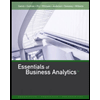
a
To evaluate: The portfolio’s performance and plot the monthly values of alpha plus residual return.
Introduction:
Alpha: Symbolically, alpha is denoted as ‘a’. It is supposed to be the difference amount that is determined after deducting the actual return from the expected return. The selection of the portfolio is made when the alpha of a portfolio is the highest.
Treynor ratio: It is named after its creator - Jack Treynor, who is an American economist. Treynor ratio tries to explore the amount of return which is generated in excess. This also is calculated for risk per unit.
a
Answer to Problem 22PS
The consumer industry has a record of good performance than the manufacturing. Even then its performance can be judged as below the benchmark.
Explanation of Solution
The information given to us is as follows:
| Month | Consumer | Manufacturing | Risk-free rate | Rm-RF | Market return | SMB | HML |
| 2012-08 | 1.84 | 1.82 | 0.9 | 2.58 | 3.48 | 0.5 | 0.79 |
| 2012-09 | 1.71 | 2.44 | 0.7 | 2.69 | 3.39 | 0.72 | 1.36 |
| 2012-10 | -0.78 | -0.82 | 1.1 | -1.7 | -0.6 | -1.31 | 3.43 |
| 2012-11 | 2.23 | 0.01 | 1.3 | 0.71 | 2.01 | 0.55 | -1.4 |
| 2012-12 | -0.87 | 1.8 | 0.4 | 1.09 | 1.49 | 1.53 | 3.56 |
| 2013-01 | 5.25 | 6.5 | 0.5 | 5.65 | 6.15 | 0.57 | 0.68 |
| 2013-02 | 1.67 | 1.09 | 0.8 | 1.27 | 2.07 | 0.07 | -0.04 |
| 2013-03 | 4.78 | 2.88 | 0.8 | 4.07 | 4.87 | 0.54 | 0.08 |
| 2013-04 | 3.16 | 0.7 | 0.5 | 1.57 | 2.07 | -2.2 | -0.05 |
| 2013-05 | 1.12 | 1.51 | 0.2 | 2.64 | 2.84 | 2.3 | 0.91 |
| 2013-06 | -0.07 | -1.71 | 0.3 | -1.12 | -0.82 | 1.44 | -0.48 |
| 2013-07 | 5.1 | 5.44 | 0.2 | 5.63 | 5.83 | 1.26 | 0.88 |
| 2013-08 | -3.86 | -2.29 | 0.4 | -2.65 | -2.25 | 0.06 | -2.17 |
| 2013-09 | 3.74 | 3.4 | 0.2 | 3.74 | 3.94 | 2.39 | -1.7 |
| 2013-10 | 4.52 | 4.44 | 1.1 | 4.23 | 5.33 | -1.4 | 1.01 |
| 2013-11 | 2.66 | 1.52 | 0.5 | 3.13 | 3.63 | 1 | 0.24 |
| 2013-12 | 1.12 | 2.83 | 0.2 | 2.7 | 2.9 | -0.57 | -0.39 |
| 2014-01 | -5.95 | -4.26 | 0.2 | -3.2 | -3 | 0.83 | -1.99 |
| 2014-02 | 4.92 | 5.13 | 0.5 | 4.57 | 5.07 | 0.27 | -0.85 |
| 2014-03 | 0.68 | 1.39 | 0.5 | 0.39 | 0.89 | -1.04 | 4.83 |
| 2014-04 | -0.04 | 2.96 | 0.2 | -0.13 | 0.07 | -3.91 | 2.69 |
| 2014-05 | 1.79 | 0.96 | 0.3 | 2.17 | 2.47 | -1.79 | -0.37 |
| 2014-06 | 1.55 | 3 | 0.2 | 2.69 | 2.89 | 2.83 | -0.67 |
| 2014-07 | -3.26 | -4.34 | 0.2 | -2.08 | -1.88 | -3.93 | -0.16 |
| 2014-08 | 5.33 | 3.97 | 0.3 | 4.21 | 4.51 | 0.69 | -1.11 |
| 2014-09 | -1.7 | -4.55 | 0.1 | -2 | -1.9 | -3.67 | -1.72 |
| 2014-10 | 2.95 | 0.73 | 0.2 | 2.35 | 2.55 | 3.08 | -0.45 |
| 2014-11 | 6.27 | -2.03 | 0.4 | 2.41 | 2.81 | -2.3 | -3.73 |
| 2014-12 | 0.09 | 0.36 | 0.3 | -0.22 | 0.08 | 2.24 | 1.15 |
| 2015-01 | -0.76 | -3.11 | 0.2 | -2.95 | -2.75 | -0.73 | -4.73 |
| 2015-02 | 5.58 | 3.83 | 0.2 | 6.11 | 6.31 | 1 | -0.29 |
| 2015-03 | -0.47 | -1.9 | 0.2 | -1.14 | -0.94 | 2.38 | -0.88 |
| 2015-04 | -1.09 | 1.76 | 0.2 | 0.75 | 0.95 | -2 | 4.17 |
| 2015-05 | 1.12 | -1.15 | 0.1 | 1.28 | 1.38 | 0.29 | -3.53 |
| 2015-06 | -0.92 | -3.06 | 0 | -1.62 | -1.62 | 2.68 | -1.42 |
| 2015-07 | 4.18 | -3.28 | 0.3 | 1.41 | 1.71 | -4.16 | -4.77 |
With the help of given information in the above table, let us calculate the average and standard for column label.
The average has to be calculated using the above formula in each of column.
The formula used is to calculate standard deviation is as follows:
Where
S=Sample standard deviation
n=The number of observations
x= The observed mean values of a sample item
The total depicts the sum of the values of 36 months. The formula of average and standard deviation is used to calculate the values for the above said columns.
| Particulars | Consumer | Manufacturing | Risk-free rate | Rm-RF | Market return | SMB | HML |
| Total | 53.59 | 27.97 | 14.7 | 51.23 | 65.93 | 0.21 | -7.12 |
| Average | 1.4886 | 0.7769 | 0.4083 | 1.4232 | 1.8314 | 0.0058 | -0.1978 |
| Standard deviation | 2.834 | 2.900 | 0.307 | 2.537 | 9.918 | 1.984 | 2.18 |
Having the values of average and standard deviation, let us now calculate the Beta, Sharpe ratio, Treynor ratio and Jenson ratio. The formulas to be used are as follows:
?where:
Covariance=Measure of a stock’s return relative to that of the market Variance=Measure of how the market moves relativeto its mean?
Sharpe ratio:
Where
S= Sharpe ratio
Rp= Return earned from portfolio
Rf= Risk-free
sp=Standard deviation of the portfolio’s return
Treynor ratio:
Where
T= Treynor ratio
Rp= Portfolio return
rf= Risk free rate of interest
ßp= Portfolio beta
By using the above said formula, we get the following values.
| Particulars | Consumer | Manufacturing | Market return |
| Beta | 0.9711 | 0.9684 | 1.0000 |
| Sharpe ratio | 0.3811 | 0.1271 | 0.5644 |
| Treynor Ratio | -0.3017 | -1.0095 | 1.4231 |
From the above calculation, it is clear that the consumer industry has a record of good performance than the manufacturing. Even then its performance can be judged as below the benchmark.
b.
To compute: The alpha plus residual returns using the Fama-French three factor model.
Introduction:
Alpha: Symbolically, alpha is denoted as ‘a’. It is supposed to be the difference amount that is got from deducting the actual return from the expected return. The selection of the portfolio is made when its alpha is the highest
Treynor ratio: It is named after its creator’s name Jack Treynor who is an American economist. Treynor ratio tries to explore the amount of return which is generated in excess. This also is calculated for risk per unit.
b.
Answer to Problem 22PS
The consumer industry has a record of good performance than the manufacturing. Even then its performance can be judged as below the benchmark.
Explanation of Solution
The information given to us is as follows:
| Month | Consumer | Manufacturing | Risk-free rate | Rm-RF | Market return | SMB | HML |
| 2012-08 | 1.84 | 1.82 | 0.9 | 2.58 | 3.48 | 0.5 | 0.79 |
| 2012-09 | 1.71 | 2.44 | 0.7 | 2.69 | 3.39 | 0.72 | 1.36 |
| 2012-10 | -0.78 | -0.82 | 1.1 | -1.7 | -0.6 | -1.31 | 3.43 |
| 2012-11 | 2.23 | 0.01 | 1.3 | 0.71 | 2.01 | 0.55 | -1.4 |
| 2012-12 | -0.87 | 1.8 | 0.4 | 1.09 | 1.49 | 1.53 | 3.56 |
| 2013-01 | 5.25 | 6.5 | 0.5 | 5.65 | 6.15 | 0.57 | 0.68 |
| 2013-02 | 1.67 | 1.09 | 0.8 | 1.27 | 2.07 | 0.07 | -0.04 |
| 2013-03 | 4.78 | 2.88 | 0.8 | 4.07 | 4.87 | 0.54 | 0.08 |
| 2013-04 | 3.16 | 0.7 | 0.5 | 1.57 | 2.07 | -2.2 | -0.05 |
| 2013-05 | 1.12 | 1.51 | 0.2 | 2.64 | 2.84 | 2.3 | 0.91 |
| 2013-06 | -0.07 | -1.71 | 0.3 | -1.12 | -0.82 | 1.44 | -0.48 |
| 2013-07 | 5.1 | 5.44 | 0.2 | 5.63 | 5.83 | 1.26 | 0.88 |
| 2013-08 | -3.86 | -2.29 | 0.4 | -2.65 | -2.25 | 0.06 | -2.17 |
| 2013-09 | 3.74 | 3.4 | 0.2 | 3.74 | 3.94 | 2.39 | -1.7 |
| 2013-10 | 4.52 | 4.44 | 1.1 | 4.23 | 5.33 | -1.4 | 1.01 |
| 2013-11 | 2.66 | 1.52 | 0.5 | 3.13 | 3.63 | 1 | 0.24 |
| 2013-12 | 1.12 | 2.83 | 0.2 | 2.7 | 2.9 | -0.57 | -0.39 |
| 2014-01 | -5.95 | -4.26 | 0.2 | -3.2 | -3 | 0.83 | -1.99 |
| 2014-02 | 4.92 | 5.13 | 0.5 | 4.57 | 5.07 | 0.27 | -0.85 |
| 2014-03 | 0.68 | 1.39 | 0.5 | 0.39 | 0.89 | -1.04 | 4.83 |
| 2014-04 | -0.04 | 2.96 | 0.2 | -0.13 | 0.07 | -3.91 | 2.69 |
| 2014-05 | 1.79 | 0.96 | 0.3 | 2.17 | 2.47 | -1.79 | -0.37 |
| 2014-06 | 1.55 | 3 | 0.2 | 2.69 | 2.89 | 2.83 | -0.67 |
| 2014-07 | -3.26 | -4.34 | 0.2 | -2.08 | -1.88 | -3.93 | -0.16 |
| 2014-08 | 5.33 | 3.97 | 0.3 | 4.21 | 4.51 | 0.69 | -1.11 |
| 2014-09 | -1.7 | -4.55 | 0.1 | -2 | -1.9 | -3.67 | -1.72 |
| 2014-10 | 2.95 | 0.73 | 0.2 | 2.35 | 2.55 | 3.08 | -0.45 |
| 2014-11 | 6.27 | -2.03 | 0.4 | 2.41 | 2.81 | -2.3 | -3.73 |
| 2014-12 | 0.09 | 0.36 | 0.3 | -0.22 | 0.08 | 2.24 | 1.15 |
| 2015-01 | -0.76 | -3.11 | 0.2 | -2.95 | -2.75 | -0.73 | -4.73 |
| 2015-02 | 5.58 | 3.83 | 0.2 | 6.11 | 6.31 | 1 | -0.29 |
| 2015-03 | -0.47 | -1.9 | 0.2 | -1.14 | -0.94 | 2.38 | -0.88 |
| 2015-04 | -1.09 | 1.76 | 0.2 | 0.75 | 0.95 | -2 | 4.17 |
| 2015-05 | 1.12 | -1.15 | 0.1 | 1.28 | 1.38 | 0.29 | -3.53 |
| 2015-06 | -0.92 | -3.06 | 0 | -1.62 | -1.62 | 2.68 | -1.42 |
| 2015-07 | 4.18 | -3.28 | 0.3 | 1.41 | 1.71 | -4.16 | -4.77 |
The Fama-French three factor model suggests the usage of market risk, size of the company and company’s book to market value to calculate the returns. The formula to be used to calculate the required returns is Jenson’s Alpha ratio.
Jensen's Alpha Ratio:
By using the above said formula, we get the following values.
| Particulars | Consumer | Manufacturing | Market return |
| Jenson’s Alpha Ratio | 1.3377 | 0.6300 | 1.6394 |
From the above calculation, it is clear that the consumer industry has a record of good performance than the manufacturing. Even then its performance can be judged as below the benchmark.
Want to see more full solutions like this?
Chapter 24 Solutions
EBK INVESTMENTS
- Which of the following is the primary function of insurance? Making risk disappear. Pooling and sharing risk among the insured. Making someone else pay for an accident or loss. Don’t know.arrow_forwardwhat is the corporate finance? explain allarrow_forwardWhich of the following has historically had the highest rate of return over long periods of time? Bank savings accounts. Bonds. Stocks. Don’t know.arrow_forward
 Essentials of Business Analytics (MindTap Course ...StatisticsISBN:9781305627734Author:Jeffrey D. Camm, James J. Cochran, Michael J. Fry, Jeffrey W. Ohlmann, David R. AndersonPublisher:Cengage Learning
Essentials of Business Analytics (MindTap Course ...StatisticsISBN:9781305627734Author:Jeffrey D. Camm, James J. Cochran, Michael J. Fry, Jeffrey W. Ohlmann, David R. AndersonPublisher:Cengage Learning EBK CONTEMPORARY FINANCIAL MANAGEMENTFinanceISBN:9781337514835Author:MOYERPublisher:CENGAGE LEARNING - CONSIGNMENT
EBK CONTEMPORARY FINANCIAL MANAGEMENTFinanceISBN:9781337514835Author:MOYERPublisher:CENGAGE LEARNING - CONSIGNMENT Cornerstones of Financial AccountingAccountingISBN:9781337690881Author:Jay Rich, Jeff JonesPublisher:Cengage Learning
Cornerstones of Financial AccountingAccountingISBN:9781337690881Author:Jay Rich, Jeff JonesPublisher:Cengage Learning Essentials Of Business AnalyticsStatisticsISBN:9781285187273Author:Camm, Jeff.Publisher:Cengage Learning,
Essentials Of Business AnalyticsStatisticsISBN:9781285187273Author:Camm, Jeff.Publisher:Cengage Learning,



